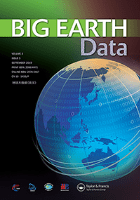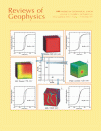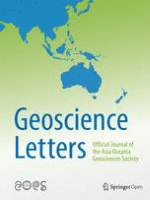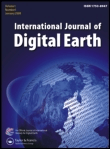
Big Earth Data
Scope & Guideline
Pioneering Research at the Intersection of Earth and Computing
Introduction
Aims and Scopes
- Earth Observation and Remote Sensing:
The journal publishes research that leverages satellite and aerial remote sensing technologies to monitor and analyze environmental phenomena, including land use change, climate impacts, and disaster management. - Data Science and Machine Learning:
A significant portion of the research involves the application of advanced data science techniques, including machine learning and deep learning, to process, analyze, and interpret large datasets from various Earth observation sources. - Sustainable Development Goals (SDGs):
The journal emphasizes research that aligns with the United Nations Sustainable Development Goals, promoting studies that utilize big Earth data to address issues such as climate change, resource management, and disaster risk reduction. - Interdisciplinary Approaches:
Research published in 'Big Earth Data' often integrates multiple disciplines, combining insights from geography, environmental science, computer science, and social sciences to provide comprehensive solutions to complex problems. - Big Data Management and Infrastructure:
The journal addresses challenges in managing and processing big Earth data, focusing on the development of frameworks, platforms, and tools that enhance data accessibility and usability for researchers and policymakers.
Trending and Emerging
- Artificial Intelligence and Machine Learning Applications:
There is a growing trend in utilizing AI and machine learning for processing and analyzing Earth observation data, enhancing the accuracy of predictions and insights drawn from large datasets. - Integration of Multi-Source Datasets:
Research increasingly focuses on combining datasets from various sources, including satellite imagery, ground-based observations, and social media data, to create comprehensive models of environmental change. - Climate Change Adaptation and Mitigation Strategies:
Emerging studies are concentrating on practical applications of big Earth data to develop strategies for climate change adaptation and mitigation, particularly in vulnerable regions and communities. - Dynamic Environmental Monitoring:
There is a rising interest in real-time and dynamic monitoring of environmental phenomena, enabled by advancements in data processing technologies and the increasing availability of real-time data streams. - Geospatial Data Visualization and Interaction:
Research is trending towards enhanced data visualization techniques, including interactive platforms and tools that facilitate user engagement and more effective communication of complex data insights.
Declining or Waning
- Traditional Remote Sensing Techniques:
Research focused solely on conventional remote sensing methods without integration of advanced data analytics or machine learning techniques is becoming less common, as the field shifts towards more innovative approaches. - Localized Case Studies:
There is a noticeable decrease in publications centered on localized case studies that do not employ big data methodologies or broader regional analyses, which are now overshadowed by studies with global or widespread applicability. - Static Data Reporting:
Papers that primarily report static datasets without dynamic analysis or predictive modeling are appearing less frequently, as the trend moves towards more interactive and predictive approaches to data. - Single-Domain Focus:
Research that restricts itself to a single domain, such as purely atmospheric studies or solely land use change, is diminishing as interdisciplinary studies that combine multiple domains gain traction. - Generalized Climate Models without Big Data Integration:
There is a decline in the publication of generalized climate models that do not leverage big data techniques, reflecting a preference for studies that utilize extensive datasets for more nuanced insights.
Similar Journals

Earth System Science Data
Catalyzing Insights into Earth's Complex SystemsEarth System Science Data, published by COPERNICUS GESELLSCHAFT MBH, is a premier open access journal dedicated to advancing the field of Earth and planetary sciences. With an impressive impact factor, it holds a distinguished Q1 ranking in the Earth and Planetary Sciences category, underscoring its significance within the scientific community. Established in 2009, the journal has been committed to providing a platform for the dissemination of high-quality, freely accessible research data that supports the understanding and management of Earth's complex systems. The journal welcomes contributions that offer extensive datasets, innovative methodologies, and collaborations that push the frontiers of Earth sciences, making it an essential resource for researchers, professionals, and students alike. Based in Göttingen, Germany, Earth System Science Data remains a vital asset for those seeking to engage with and contribute to impactful scientific discourse across the globe.

Science China-Earth Sciences
Empowering Researchers with Open Access to Groundbreaking Findings.Science China-Earth Sciences, published by SCIENCE PRESS, stands as a leading journal in the field of Earth and Planetary Sciences, currently holding a prestigious Q1 ranking in the 2023 category and positioned at Rank #12 out of 195 in Scopus, reflecting its significance with an impressive 94th percentile. Specializing in a wide array of topics including geological processes, environmental science, and planetary studies, the journal serves as a vital resource for researchers, professionals, and students alike, fostering interdisciplinary collaboration and advanced scientific discourse. With a commitment to accessibility and knowledge dissemination, Science China-Earth Sciences offers an Open Access model, ensuring that high-quality research is available to a global audience. Situated in Beijing, China, this journal is dedicated to promoting innovative scientific advancements and understanding the complexities of our planet from 2010 to 2024 and beyond. As such, it remains essential for anyone engaged in the dynamic and evolving field of Earth sciences.

REVIEWS OF GEOPHYSICS
Elevating Earth Science through Critical Insights.REVIEWS OF GEOPHYSICS is a prestigious journal published by the American Geophysical Union, renowned for its critical contributions to the field of geophysics since its inception in 1963. With an impact factor that signifies its scholarly excellence and a Q1 ranking in Geophysics (2023), this journal is the leading platform for disseminating groundbreaking research across Earth and Planetary Sciences, currently holding the top position in its category. As a valuable resource for researchers, professionals, and students alike, it offers comprehensive reviews that synthesize significant advancements and theoretical insights, fostering the exchange of innovative ideas within the geophysical community. Although typically not an open-access journal, its influence is bolstered by its rigorous peer-review process and publication standards, ensuring that each article meets the highest academic criteria. Well-positioned in the heart of Washington, DC, the journal remains an essential reference for those seeking to remain at the forefront of geophysical research developments.

Geoscience Letters
Elevating Geoscience Research to New HeightsGeoscience Letters, published by Springer, is a prominent open-access journal in the field of Earth and Planetary Sciences, recognized for its dedication to advancing knowledge and research in this vital area of study. With a reported impact factor that reflects its esteemed position—ranking in the Q1 quartile of Earth and Planetary Sciences, particularly as the journal ranks #48 out of 195 in the general category according to Scopus—the journal serves as a vital resource for researchers, professionals, and students. Since its inception in 2014, Geoscience Letters has facilitated the dissemination of high-quality research and critical insights, aiming to bridge the gap between scientific discovery and societal needs. Its commitment to open access ensures that the latest findings are readily available to a global audience, thus enhancing collaboration and innovation within the geosciences community.

Vietnam Journal of Earth Sciences
Advancing Knowledge in Earth and Planetary SciencesThe Vietnam Journal of Earth Sciences, ISSN 0866-7187, is a premier publication from the Publishing House Science and Technology based in Viet Nam, dedicated to fostering advancements in the field of Earth and Planetary Sciences. Operating under a Q2 ranking in the 2023 category of Earth and Planetary Sciences (miscellaneous) and positioned at Rank #62 out of 195 in its general category on Scopus, this journal serves as a critical platform for researchers, professionals, and students seeking to disseminate and engage with high-quality scientific findings. Despite being part of the non-open access model, the journal is committed to providing compelling content, encompassing a range of topics from geological hazards to environmental sustainability, ensuring its relevance and contribution to both local and international scientific communities. With coverage that spans from 2018 to 2024, the journal is poised to continue its role in addressing pressing Earth science issues and fostering collaborations among scholars in an increasingly interconnected world.

Earth Science Informatics
Harnessing Informatics to Unlock Earth's Secrets.Earth Science Informatics, published by SPRINGER HEIDELBERG, serves as a premier platform for disseminating innovative research in the realm of Earth and Planetary Sciences. With an ISSN of 1865-0473 and an E-ISSN of 1865-0481, this journal offers insightful contributions that leverage informatics and data-driven approaches to address complex geoscientific challenges. As a testament to its impact in the field, it ranks in the Q2 quartile and holds an impressive 73rd percentile rank among 195 journals in the broader **Earth and Planetary Sciences** category, as per Scopus rankings. This journal invites researchers, professionals, and students to explore and contribute to the growing body of knowledge that bridges the gap between informatics and Earth science, fostering advancements in both theoretical frameworks and practical applications. Situated in Germany, at TIERGARTENSTRASSE 17, D-69121 HEIDELBERG, it aims to enhance interdisciplinary collaboration and propel scientific discovery from 2009 to 2024 and beyond, reinforcing its vital role in the academic community.

International Journal of Data Science and Analytics
Transforming Ideas into Impactful Data SolutionsInternational Journal of Data Science and Analytics, published by SpringerNature, is a leading peer-reviewed journal dedicated to advancing the fields of data science and analytics. Since its inception in 2016, the journal has become an essential platform for researchers, professionals, and students, promoting the exchange of innovative ideas and cutting-edge research. With an impressive categorization in Q2 across multiple domains including Applied Mathematics, Computational Theory and Mathematics, and Information Systems, it demonstrates a notable impact within the academic community, as reflected by its high rankings in various Scopus categories. The journal emphasizes rigorous methodologies and practical applications of data science, making it a valuable resource for those seeking to enhance their understanding and application of data-driven solutions. Although it currently does not operate as an open-access journal, it is committed to disseminating high-quality research that shapes the future of analytics and computation. The journal's headquarters in Switzerland further enriches its international scope, fostering a global dialogue among scholars and practitioners alike.

International Journal of Applied Earth Observation and Geoinformation
Bridging Science and Technology for Global Change.International Journal of Applied Earth Observation and Geoinformation is a premier peer-reviewed journal published by Elsevier, focusing on the integration and application of earth observation and geoinformation technologies across diverse fields. With an open access model established in 2020, this journal enhances accessibility and dissemination of research crucial for addressing global challenges related to climate change, resource management, and sustainable development. The journal occupies a notable position within the academic community, featuring a Q1 ranking in multiple categories including Computers in Earth Sciences, Earth-Surface Processes, and Global and Planetary Change, reflecting its significant impact and relevance in these disciplines. It is recognized for its high-quality articles that explore innovative methodologies and applications, making it an essential resource for researchers, practitioners, and students alike who seek to advance their understanding of earth dynamics and geospatial technology. The journal is indexed in Scopus with impressive rankings that underscore its high citation impact and scholarly influence, with an emphasis on providing a platform for the latest findings in management, monitoring, and policy in environmental science.

Journal of Geovisualization and Spatial Analysis
Empowering Scholars with Open Access to Geospatial DiscoveriesJournal of Geovisualization and Spatial Analysis, published by SpringerNature, is an influential open-access journal specializing in the cutting-edge fields of geovisualization, spatial analysis, and their application in earth sciences and geography. Since its inception in 2017, this journal has established a prominent stance with a high impact factor and prestigious Q1 rankings across multiple categories, including Computers in Earth Sciences, Earth and Planetary Sciences (miscellaneous), and Geography, Planning and Development. The editorial board is committed to advancing innovative research and methodologies, providing a platform for scholars to disseminate their findings globally. With impressive Scopus rankings—placing it in the top percentiles among its peers—the journal serves as a vital resource for researchers, professionals, and students keen on understanding spatial data and its implications for geographic science. Its emphasis on rigorous peer review and rapid publication enhances accessibility to substantive research, thus fostering knowledge sharing within the scientific community. Based in Switzerland, the journal promotes a collaborative environment for interdisciplinary studies, making it an essential read for anyone involved in spatial analysis research.

International Journal of Digital Earth
Fostering collaboration in the realm of digital Earth sciences.Welcome to the International Journal of Digital Earth, a premier open-access journal published by Taylor & Francis Ltd, dedicated to advancing the field of digital geoscience. With its ISSN 1753-8947 and E-ISSN 1753-8955, this journal has established itself as a vital resource for scholars and practitioners alike since its inception in 2008. The journal is at the forefront of interdisciplinary research, showcasing a diverse scope from Earth sciences to computer science applications, evidenced by its impressive ranking in the 2023 Scopus database. It holds a Q1 categorization in Earth and Planetary Sciences, with a percentile rank among the top 16% of its peers, and also stands out in the Q2 quartile for both Computer Science Applications and Software disciplines. The journal's commitment to open access, established in 2022, underscores its dedication to disseminating knowledge and fostering collaboration. By providing a platform for high-quality research, the International Journal of Digital Earth plays a critical role in addressing the complexities of our changing planet through innovative digital solutions. Whether you are an experienced researcher or a student, this journal is an essential addition to your academic toolkit.